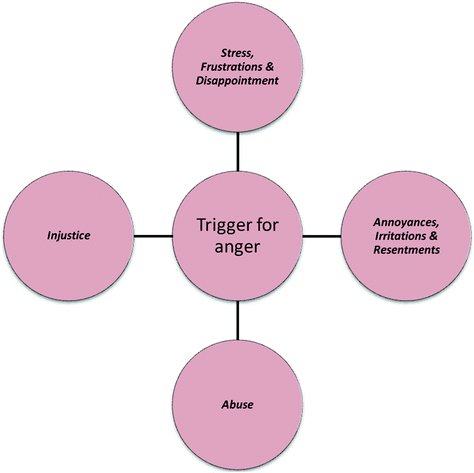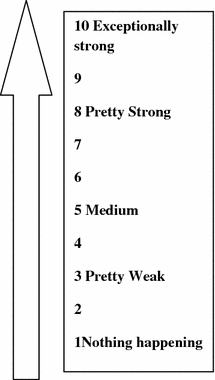Self-report inventory
Developed by
Description
State-trait anger expression inventory-2 (STAXI-2)
Spielberger (1999)
57-item, self-report behavior inventory that measures the experience, expression, and control of anger of adolescents and adults, ages 16–63
Multidimensional anger inventory (MAI)
Siegel (1986)
Measures reports of anger frequency, duration and magnitude, range of anger arousing stimuli, mode of anger expression, and hostile outlook, of adults ages 40–63
Anger discomfort scale (ADS)
Sharkin and Gelso (1991)
15 items, that are designed to assess the construct of anger discomfort of individuals ages 18–38
Children’s inventory of anger
Nelson et al. (1993)
Measures the intensity of anger of children ages 6–16. Specifically, this measure presents stick-figure drawings of facial expressions that correspond to a 4-point Likert-type scale
Multidimensional school anger inventory (MSAI)
Smith et al. (1998)
A self-report rating scale that assesses anger arousal, cynical hostility, and negative anger expression in students grades 6–12. It is composed of 36 items that involve responding to anger situations by referencing a 4-point Likert-type scale
Adolescent anger rating scale (AARS)
Burney (2001)
A 41-item, self-report, Likert-type rating scale designed to identify reactive anger, instrumental anger, anger control, and total anger of adolescents ages 11–19
In addition to self-report measures, anger may also be recorded through direct and indirect observation techniques. Methods of observation may include behavioral analysis chart, anger diaries, and behavioral displays of anger. Finally, regarding psychophysiological recordings, these techniques involve the incorporation of biofeedback practices into measuring one’s level of anger. Specifically, physiological responses that are related to respiratory and motoric functions are monitored and may include heart rate, irregular breathing, muscle stiffness, perspiring, and blood pressure.
6.9 Management of Anger
Anger management training typically involves providing information on the cognitive and behavioral components of anger, teaching cognitive and behavioral techniques to manage anger, and encouraging the application of newly learned skills in the real-world setting. Cognitive behavioral techniques attempt to intervene with cognitive, emotional, and physiological components of anger. Specifically, cognitive–behavioral interventions designed to address anger may include one or more of the following: self-awareness training, relaxation techniques, cognitive therapy, and conflict management skill training (Deffenbacher 1999). In a study, with objective of reviewing current approaches to assessment and management of anger and aggression in the youth, Blake and Hamrin (2007) found that cognitive–behavioral and skills-based approaches are the most widely studied and empirically validated treatments for anger and aggression in the youth.
6.10 CBT-Based Anger Management Training Module
This module emphasizes the interactive role of emotion, cognitions and behavior in the development and maintenance of mental health problems. This aims at enabling adolescents to acquire skills and techniques to deal with anger arousing stressors and help them to use these skills to understand and manage their anger. The techniques for anger management can be divided into two broad categories: quick anger control strategies and long-term anger control strategies. In this module, sessions 2 and 3 are about quick anger control training and sessions 4 and 5 talk about long-term anger control training.
6.11 Sessions
The module can be delivered across six sessions covering following broad areas as mentioned below:
To develop understanding about anger.
To learn to look for the triggers for anger.
To learn relaxation skills.
To learn and implement rational restructuring to identify and change irrational thoughts which are a cause of expressing anger.
To learn positive social skills and assertiveness to communicate feelings and thoughts in a socially acceptable manner (Table 6.2).
Table 6.2
Sessions in anger management
Session no.
Aims of sessions
Session 1: psychoeducation
To make the client able to understand more about their own anger and how it affects and factors which can worsen it
Session 2: early warning signs and their quick control
To become able to recognize the early warning signs of anger and quick ways of controlling anger
Session 3: strategies to manage anger
To learn various strategies of managing anger, e.g., self talk and frustration tolerance
Session 4: communication skills
To develop more helpful and healthy ways of communication
Session 5: cognitive restructuring
To develop more helpful and healthy thoughts about situations that lead to anger
Session 6: review and challenge of maintaining the change
To cope with challenges to manage anger, setbacks, and how to increase the chances of success
6.11.1 Session 1: Psychoeducation: Understanding Anger
This session would focus on increasing understanding about anger. All of us experience anger. Anger is often a sign that indicates that something is not right. If we feel something wrong is happening, we may feel angry. Anger can lead to difficulties in handling interpersonal relationships, health related problems, declining work performance, and difficulties with law.
6.11.1.1 Anger Effects the Body
When people feel anger they may notice some of the following effects on their body:
Muscular tension
Faster breathing
Dilation of pupil
Sweating
6.11.1.2 Anger Effects Behavior
Angry behaviors are often the signs that are noticed. Some angry behaviors could be as follows:
Hitting
Screaming
Throwing items
Clenching fists
Self-harm
6.11.1.3 Anger Effects Thought Process
It is actually not the situation itself that makes us feel angry, rather it is the way that a person appraises a situation that causes anger. For example,
He is so jealous of my success.
He always tries to make me feel like a fool.
I hate this world.
My teacher is biased.
6.11.1.4 Homework Assignment 1: Breaking up the Anger
Think about the times when you felt angry and give your responses to the following
How was your body effected | What types of thoughts come to your mind | How do you react when you get angry |
|---|---|---|
. | . | . |
. | . | . |
. | . | . |
6.11.1.5 Triggers for Anger
Anger is an emotional reaction to events or things which happen around us. Following are some of the main triggers which can cause anger (Fig. 6.1).


Fig. 6.1
Types of anger triggers
Now, let us see how a trigger can generate anger in a specific situation.
Sarita, 17-years-old girl, had been on at her younger sister all day to arrange and clean her room and she kept saying she would do it in a minute or a bit later. Early in the evening, Sarita found her sister sitting in front of dressing table mirror just trying a new hairstyle. She saw her sister as deliberately provoking her saying “what are you going to do about it then?” (annoyance).
She had felt stressed all day. When she saw her sister in front of the mirror, she completely lost her wits and she could feel her fists clench and her voice got louder. These changes happened in the space of a couple of minutes. She thought “my sister is completely useless, she has got no respect for me” She shouted and screamed at her sister for around 20 min. Later, her sister cleaned her room.
Here, the younger sister not doing her tasks is the trigger for Sarita’s anger, and it was followed by the angry thought in Sarita’s mind that her sister does not respect her she completely lost her temper, she clenched her fist and screamed louder and expressed her anger.
6.11.1.6 Homework Assignment 2: Getting to Know Your Anger Triggers
Think about what sort of things generate your anger and write them down.
Particular place
Certain people
What really gets their anger going
6.11.2 Session 2: Early Warning Signs and Quick Anger Control
Recognizing when we get angry is the first important step in managing of our anger. This can be done easily by noticing the bodily sensations linked with anger.
6.11.2.1 Bodily Sensations
When we get angry, our body also reacts. These bodily sensations include feeling tension in muscles, sweating, and breathing faster. These sensations are a reaction to stressful condition and technically it is called “fight–flight response”. A number of physical reactions occur when body goes into fight–flight, these include:
Faster breathing
Dilation of pupils
Sweating
Anger Thermometer: Keeping a track of anger on an anger thermometer can be a useful way of measuring anger. Consider the following (Fig. 6.2).


Fig. 6.2
Anger thermometer
When there is a change in our feelings, it goes up and down on the thermometer. It is not possible to jump from 0° to 100° without going through all the other temperatures. It is the same with anger, anger is also not an all or nothing emotion, and we move gradually upwards on the scale before we reach the top. Thus, when thinking about anger control, a person will need to do something before he gets “too hot” and go too far up the thermometer.
6.11.3 Stop, Think, Go
The aim of this section is to learn and understand how one can act thoughtfully rather than reacting without thinking.
6.11.3.1 Time-Out
The principle behind this strategy is that all of us need time to think about what we are going to do to stop ourselves getting angry. Ways in which a person might buy himself some time include the following:
Walk away
Count to ten
Distract
Keep quiet/bite their tongue
6.11.3.2 Deep Breathing
Deep breathing is a quick way to calm the body. When we are stressed, our breathing becomes faster and shallower that results in increasing the effects of stress on our body. Calming down the breathing can help to control arousal levels of body quickly.
How to Practice Deep Breathing
See Annexure for detail.
6.11.4 Session 3: Strategies to Manage Anger
Anger is not always inevitable, and people can probably think of some instances which were anger arousing, but for some reason, they did not show their anger. There can be a number of reasons for not reacting angrily. One possible reason might be that they anticipated that the costs of getting angry would be too high. Another reason that people might not get angry could be that they use a strategy to manage their anger. For example,
Tanya
Tanya was really angry when she was standing in a queue to buy movie tickets. Someone had pushed her aside to get to the tickets and she was thinking “how rude, have they no manners”. She realized she was beginning to boil and decided to walk away and count to 10.
6.11.4.1 Homework Assignment 1: Are There Things that You Already Do?
The strategies described in this session are research-based and are tried and tested and are very helpful in having a quick control on anger. Clients need to persevere, practise, and plan to get the best results from them. These ideas may be probably not new to the clients, and they are not the only way to stop or reduce their anger. They may already be doing other things that help. This session we will consider the following issues and strategies:
1.
Positive self-talk
2.
Frustration tolerance
3.
Reducing venting
4.
Controlling unhealthy rumination
5.
Problem solving
Positive Self Talk
It is not necessary that all people get angry. Two people in the situation may not both get angry; the difference lies in how they think about the situation.
Example Your friends do not pass a smile to you when they see you in party. You think:
1.




How rude, they must be deliberately ignoring me
Stay updated, free articles. Join our Telegram channel

Full access? Get Clinical Tree







